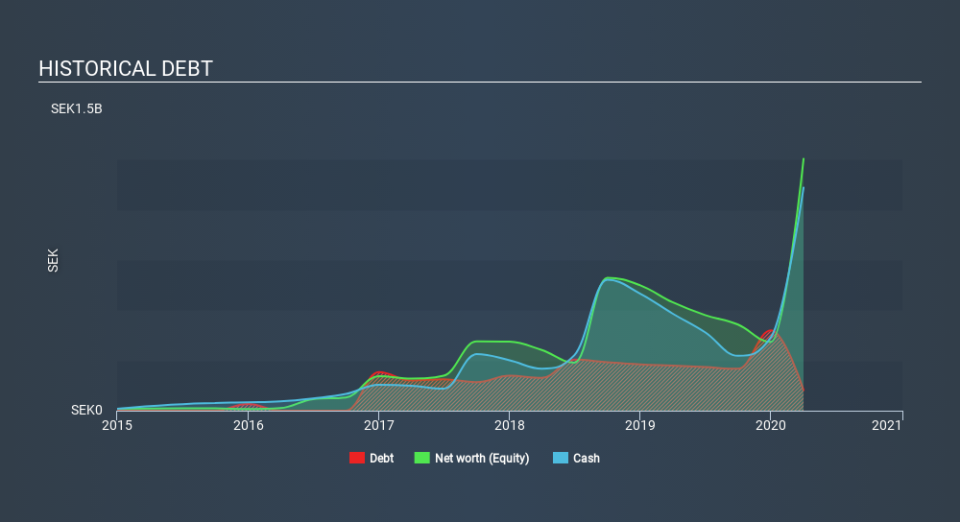Storytel (STO:STORY B) Has Debt But No Earnings; Should You Worry?

David Iben put it well when he said, 'Volatility is not a risk we care about. What we care about is avoiding the permanent loss of capital. So it might be obvious that you need to consider debt, when you think about how risky any given stock is, because too much debt can sink a company. We note that Storytel AB (publ) (STO:STORY B) does have debt on its balance sheet. But should shareholders be worried about its use of debt?
When Is Debt Dangerous?
Generally speaking, debt only becomes a real problem when a company can't easily pay it off, either by raising capital or with its own cash flow. If things get really bad, the lenders can take control of the business. While that is not too common, we often do see indebted companies permanently diluting shareholders because lenders force them to raise capital at a distressed price. By replacing dilution, though, debt can be an extremely good tool for businesses that need capital to invest in growth at high rates of return. The first step when considering a company's debt levels is to consider its cash and debt together.
See our latest analysis for Storytel
What Is Storytel's Debt?
You can click the graphic below for the historical numbers, but it shows that Storytel had kr102.5m of debt in March 2020, down from kr224.8m, one year before. However, its balance sheet shows it holds kr1.11b in cash, so it actually has kr1.01b net cash.
A Look At Storytel's Liabilities
Zooming in on the latest balance sheet data, we can see that Storytel had liabilities of kr708.8m due within 12 months and liabilities of kr145.5m due beyond that. Offsetting these obligations, it had cash of kr1.11b as well as receivables valued at kr458.0m due within 12 months. So it can boast kr714.0m more liquid assets than total liabilities.
This short term liquidity is a sign that Storytel could probably pay off its debt with ease, as its balance sheet is far from stretched. Simply put, the fact that Storytel has more cash than debt is arguably a good indication that it can manage its debt safely. There's no doubt that we learn most about debt from the balance sheet. But it is future earnings, more than anything, that will determine Storytel's ability to maintain a healthy balance sheet going forward. So if you're focused on the future you can check out this free report showing analyst profit forecasts.
Over 12 months, Storytel reported revenue of kr2.0b, which is a gain of 31%, although it did not report any earnings before interest and tax. With any luck the company will be able to grow its way to profitability.
So How Risky Is Storytel?
We have no doubt that loss making companies are, in general, riskier than profitable ones. And the fact is that over the last twelve months Storytel lost money at the earnings before interest and tax (EBIT) line. And over the same period it saw negative free cash outflow of kr316m and booked a kr261m accounting loss. While this does make the company a bit risky, it's important to remember it has net cash of kr1.01b. That kitty means the company can keep spending for growth for at least two years, at current rates. With very solid revenue growth in the last year, Storytel may be on a path to profitability. Pre-profit companies are often risky, but they can also offer great rewards. When analysing debt levels, the balance sheet is the obvious place to start. But ultimately, every company can contain risks that exist outside of the balance sheet. Take risks, for example - Storytel has 4 warning signs we think you should be aware of.
If, after all that, you're more interested in a fast growing company with a rock-solid balance sheet, then check out our list of net cash growth stocks without delay.
If you spot an error that warrants correction, please contact the editor at editorial-team@simplywallst.com. This article by Simply Wall St is general in nature. It does not constitute a recommendation to buy or sell any stock, and does not take account of your objectives, or your financial situation. Simply Wall St has no position in the stocks mentioned.
We aim to bring you long-term focused research analysis driven by fundamental data. Note that our analysis may not factor in the latest price-sensitive company announcements or qualitative material. Thank you for reading.

 Yahoo Finance
Yahoo Finance 
